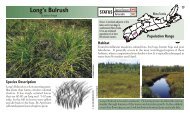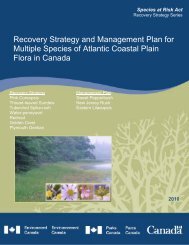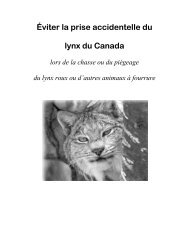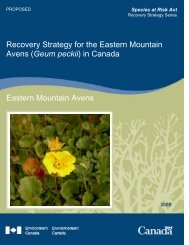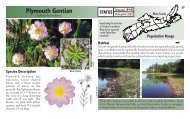Healthy Lakes and Wetlands For Tomorrow - Species at Risk
Healthy Lakes and Wetlands For Tomorrow - Species at Risk
Healthy Lakes and Wetlands For Tomorrow - Species at Risk
Create successful ePaper yourself
Turn your PDF publications into a flip-book with our unique Google optimized e-Paper software.
NEW JERSEY RUSH<br />
Found along the edges of small bays<br />
or coves of bogs <strong>and</strong> fens <strong>and</strong> in<br />
small boggy openings in coniferous<br />
woods. Requires open conditions<br />
<strong>and</strong> moder<strong>at</strong>e disturbance.<br />
Found in wet areas but does not<br />
grow well in prolonged st<strong>and</strong>ing<br />
w<strong>at</strong>er.<br />
Sensitive to changing w<strong>at</strong>er levels<br />
<strong>and</strong> neg<strong>at</strong>ively affected by events<br />
such as site drainage or flooding.<br />
R. Newell<br />
GOLDEN CREST<br />
In addition to lake shorelines, this<br />
species is found in bogs <strong>and</strong> fens.<br />
Tends to grow in w<strong>at</strong>erlogged <strong>and</strong><br />
seasonally flooded areas.<br />
Associ<strong>at</strong>ed with Twigrush (pg 11).<br />
ESTUARINE HABITAT<br />
M. Crowley<br />
M. Crowley<br />
ESTUARIES<br />
Estuaries are biologically productive regions where rivers <strong>and</strong> near-shore ocean w<strong>at</strong>ers<br />
meet <strong>and</strong> cre<strong>at</strong>e a mixing of freshw<strong>at</strong>er <strong>and</strong> saltw<strong>at</strong>er. They contain species th<strong>at</strong> are<br />
specially adapted to living in brackish conditions <strong>and</strong> changing w<strong>at</strong>er levels.<br />
EASTERN LILAEOPSIS<br />
The only Atlantic Coastal Plain Flora species <strong>at</strong> risk found in estuaries.<br />
Loc<strong>at</strong>ed in the intertidal zone, mainly on gentle, muddy slopes, <strong>and</strong> occasionally on<br />
gentle slopes of fine gravel. Associ<strong>at</strong>ed with Saltw<strong>at</strong>er Cordgrass.<br />
May be submerged under two meters of w<strong>at</strong>er for part of each day.<br />
Generally found in estuaries with a long, narrow, rectangular shape.<br />
13<br />
Eastern Lilaeopsis growing under Saltw<strong>at</strong>er Cordgrass.<br />
M. Crowley




